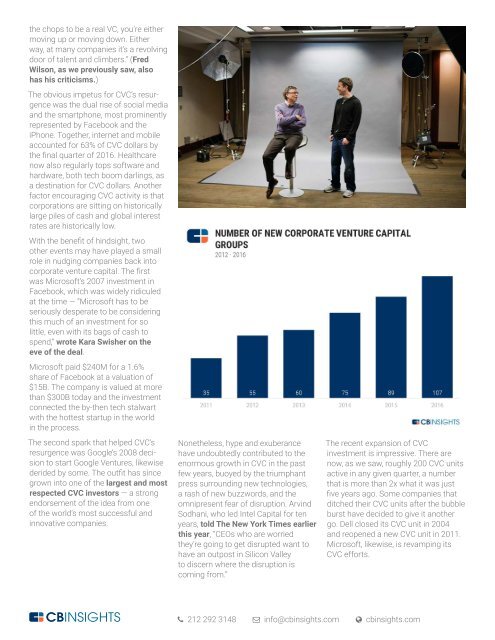THE HISTORY OF CVC
2nruRFS
2nruRFS
Create successful ePaper yourself
Turn your PDF publications into a flip-book with our unique Google optimized e-Paper software.
the chops to be a real VC, you’re either<br />
moving up or moving down. Either<br />
way, at many companies it’s a revolving<br />
door of talent and climbers.” (Fred<br />
Wilson, as we previously saw, also<br />
has his criticisms.)<br />
The obvious impetus for <strong>CVC</strong>’s resurgence<br />
was the dual rise of social media<br />
and the smartphone, most prominently<br />
represented by Facebook and the<br />
iPhone. Together, internet and mobile<br />
accounted for 63% of <strong>CVC</strong> dollars by<br />
the final quarter of 2016. Healthcare<br />
now also regularly tops software and<br />
hardware, both tech boom darlings, as<br />
a destination for <strong>CVC</strong> dollars. Another<br />
factor encouraging <strong>CVC</strong> activity is that<br />
corporations are sitting on historically<br />
large piles of cash and global interest<br />
rates are historically low.<br />
With the benefit of hindsight, two<br />
other events may have played a small<br />
role in nudging companies back into<br />
corporate venture capital. The first<br />
was Microsoft’s 2007 investment in<br />
Facebook, which was widely ridiculed<br />
at the time — ”Microsoft has to be<br />
seriously desperate to be considering<br />
this much of an investment for so<br />
little, even with its bags of cash to<br />
spend,” wrote Kara Swisher on the<br />
eve of the deal.<br />
Microsoft paid $240M for a 1.6%<br />
share of Facebook at a valuation of<br />
$15B. The company is valued at more<br />
than $300B today and the investment<br />
connected the by-then tech stalwart<br />
with the hottest startup in the world<br />
in the process.<br />
The second spark that helped <strong>CVC</strong>’s<br />
resurgence was Google’s 2008 decision<br />
to start Google Ventures, likewise<br />
derided by some. The outfit has since<br />
grown into one of the largest and most<br />
respected <strong>CVC</strong> investors — a strong<br />
endorsement of the idea from one<br />
of the world’s most successful and<br />
innovative companies.<br />
Nonetheless, hype and exuberance<br />
have undoubtedly contributed to the<br />
enormous growth in <strong>CVC</strong> in the past<br />
few years, buoyed by the triumphant<br />
press surrounding new technologies,<br />
a rash of new buzzwords, and the<br />
omnipresent fear of disruption. Arvind<br />
Sodhani, who led Intel Capital for ten<br />
years, told The New York Times earlier<br />
this year, “CEOs who are worried<br />
they’re going to get disrupted want to<br />
have an outpost in Silicon Valley<br />
to discern where the disruption is<br />
coming from.”<br />
The recent expansion of <strong>CVC</strong><br />
investment is impressive. There are<br />
now, as we saw, roughly 200 <strong>CVC</strong> units<br />
active in any given quarter, a number<br />
that is more than 2x what it was just<br />
five years ago. Some companies that<br />
ditched their <strong>CVC</strong> units after the bubble<br />
burst have decided to give it another<br />
go. Dell closed its <strong>CVC</strong> unit in 2004<br />
and reopened a new <strong>CVC</strong> unit in 2011.<br />
Microsoft, likewise, is revamping its<br />
<strong>CVC</strong> efforts.<br />
212 292 3148 info@cbinsights.com cbinsights.com















